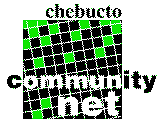

HTML stands for Hypertext Markup Language. If you ask a technically inclined person, they might tell you that it is a text formatting language used on the World Wide Web. From a layperson's point of view, it is a series of codes used to put information on a "home page" on the Internet. Who is correct? Both.
HTML is format for all documents on CCN. HTML describes the logical structure of the document, not its appearance, and the way the document is displayed depends on the browser you're using. There are two types of browsers available: text based and graphical. Lynx is text based and cannot view graphics. It is the interface most CCN users see when they dial up. Netscape, as one example is graphical. Netscape is used on the Public Access Terminals which can be found at the Halifax City Regional Library. HTML source code should be written so that it looks good on both types of browsers. It is used on CCN because it is the format of most documents used on the World Wide Web.
If you've ever used WordPerfect, you may have seen "reveal codes". Looking at "reveal codes" will show codes used to format the document. It is a similar concept for HTML. For example, to bold a phrase in HTML, the following code might be used.
<strong>This text is in bold</strong>
The output would look like this: This text is in bold
All that is required to format the text are the codes between the < sign, and the > sign. So <strong> is considered a code, commonly known as a tag. A pair of tags, such as <strong> and </strong> is known as an element. One thing to note is that in paired tags, the delimiters for the beginning tag are < and >. The delimiters for the ending tag are </ and >.
There are many examples of tags and elements used in HTML. Some tags are used by themselves, such as <p> and some are used as a pair, such as <em> </em>. In Lynx, the HTML source code can be seen by pressing the '\' key. Try this now.
Also note that what you see is not always what you get. Bold text in Netscape may not be bold in Lynx. A bulleted list in Mosaic might not be the same as one in Netscape even though the codes are the same. All codes are dependent upon how your browser wants to interpret it.
If you have done a bit of web browsing, you'll notice that an HTML document has structure, much like books or any reading material. Just looking at this page will reveal that it contains paragraphs, section headings, and lists. Links to other documents are also important, they are covered in the next tutorial.
So what's next? Learning some of the basics.
[next: The Minimal HTML Document] [previous] [contents]
Originally written by Bonny Lee and Carol Wulfman for CCN Community Net Training. Edited by Robert Adams. Last modified 1996/03/08 15:43:55 by helpdoc